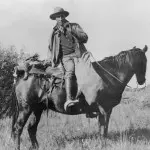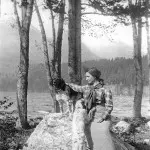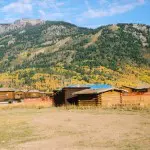In 1906 Louis Joy filed for 160 acres under the Desert Land Act of 1877 on the south side of Phelps Lake. After making the necessary improvements and receiving a patent for the land, he filed a cash entry on an adjacent 119 acre homestead. Only a year later, in 1908, the ranch hosted the first five dudes in the Jackson Hole valley. All five were friends or acquaintances of a young man from Philadelphia with a degree from Princeton University. Maxwell Struthers Burt came from a wealthy family in Philadelphia and had a very different upbringing than Louis Joy. Joy had been born and raised in the East, but he moved to a large ranch in the Southwest when he turned 18. There he learned the ranch skills of a cowboy, foreman, cook and guide. Between Burt’s wealthy connections in the east and Joy’s knowledge and ranching skills it seemed they had formed the perfect partnership. Over the next three years, however, the men shared a strained relationship at the JY. Initially promised a five-year option to buy a half-interest in the ranch, it soon became clear to Burt that this would not come to fruition. In 1911, frustrated and feeling used for this social contacts, Burt split from Louis Joy and the JY Ranch with the intention of starting off on his own.
Fortunately for Joy, Burt’s departure did not affect business at the ranch. He had already established a solid base of seasonal dudes and could do without his former partner’s contacts. Running the ranch on his own proved to be a daunting task and in 1916 Joy leased the ranch to Henry S. A. Stewart, who was from Pittsburg. By 1920 Stewart had purchased the ranch from Joy and expanded his land holdings with adjacent parcels in order to begin raising cattle. By 1927, Stewart had grown the JY to become the largest dude ranch in the valley. The ranch could host up to 65 dudes at a time, which was quite a feat considering most could only handle 10-20. Rates were $65.00 per week, with meals, lodging, boats and saddle horses included. With such a prime location at the base of Phelp’s Lake, the JY could offer a large variety of activities. These included swimming, fishing, boating, mountain climbing, horseback riding, hunting and camping.
Stewart proved to be a shrewd businessman and able ranch owner, and offered unusual comforts for the valley. He purchased a second nearby ranch in order to supply the JY with fresh garden vegetables, dairy and beef. Beef was the valley’s prime export, most locals ate meats like Elk rather than their only source of income. To be able to offer his dudes fresh beef was considered a luxury found nowhere else in the valley. Another specialty that began at the JY was private motor tours of the Jackson Hole valley and Yellowstone National Park. For an extra $50.00 dudes could be driven to some of the most well-known natural sites and geysers in the country. The JY was nothing if not self-sufficient. Stewart also operated a general store that sold fishing licenses, camping clothes, tobacco, candy, cigarettes and medicine. This was exceedingly rare for a dude ranch, and the JY was the only dude ranch in the valley to operate such a convenience.
Stewart once again proved his ability to keep the ranch running in top shape during the depression of the 1930s. He raised rates to $75.00 a week and lowered capacity. Most other ranches in the valley were cutting their rates in half and hosting well under their normal capacities. This plan kept the JY afloat during the economic hardships, but Stewart chose to sell the ranch to the Snake River Land Company in 1932 for $49,000. The listing included a farm, a homestead and 20 dude cabins. The ranch would continue to survive under private ownership with John D. Rockefeller and his family.
Over the next several decades, the Rockefellers would continue to visit the valley and kept this ranch as their summer retreat. They eventually donated portions of the vast lands Stewart had amassed to the Grand Teton National Park. In 2001 the last parcel was handed over to the National Park Service, the donations totaling more than 3,000 acres. In 2008 the Laurence S. Rockefeller Preserve was opened to the public for continued enjoyment of the natural areas the Rockefellers had kept private for the last 76 years. The original ranch buildings have been moved to different locations, some were given to the Grand Teton National Park and are still in use today. The rest were moved to the Rockefellers’ private ranch that is located outside of the park boundaries.
The JY was the first and the largest ranch in the Jackson Hole valley. The success of the JY would open the door for all of the other dude ranches that were created over the next few years. The Bar BC, created by Louis Joy’s former partner, Struthers Burt would be directly responsible for the creation of no less than 12 other ranches and homesteads. Louis Joy and the JY Ranch would be responsible for a movement that would later define Jackson Hole and create one of the best-known valleys for dude ranching.
Text by Samantha Ford, Director of Historical Research and Outreach


